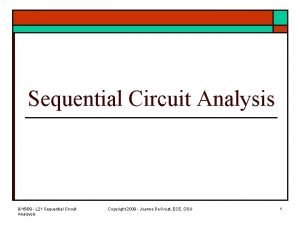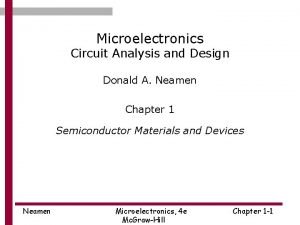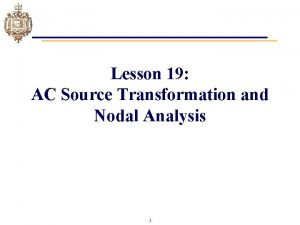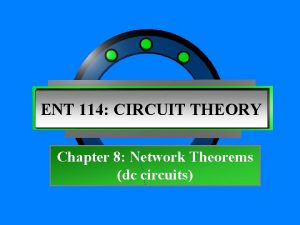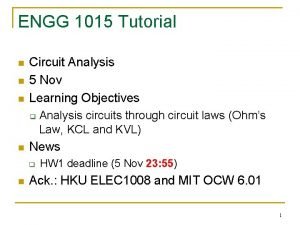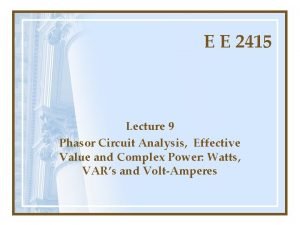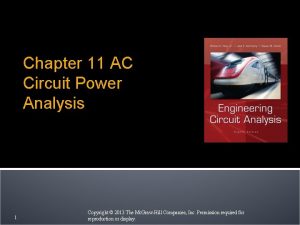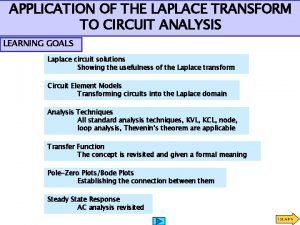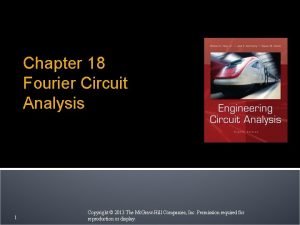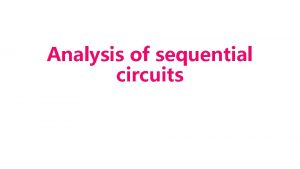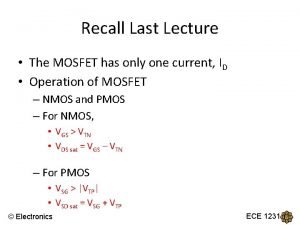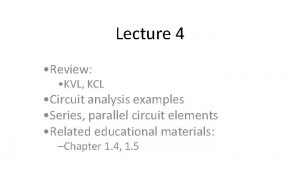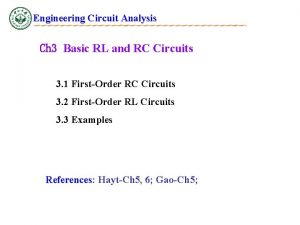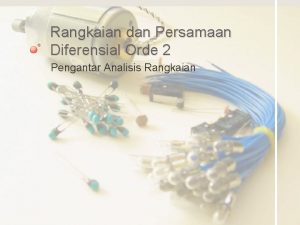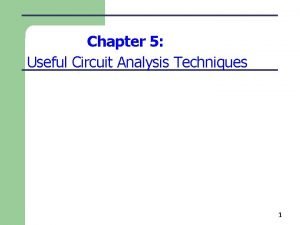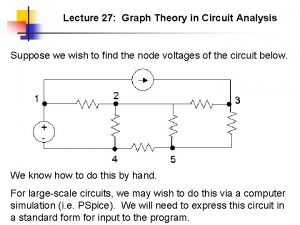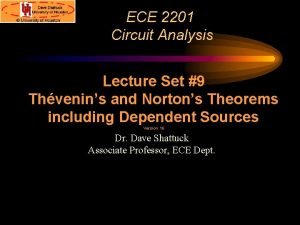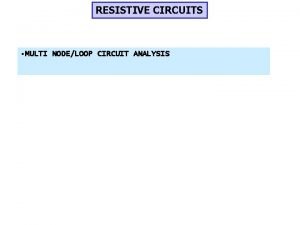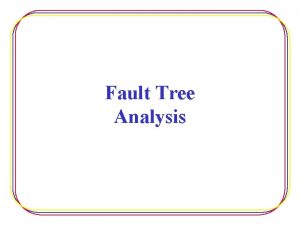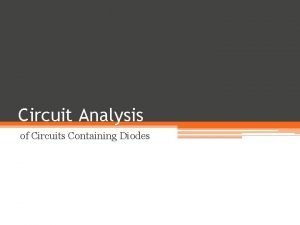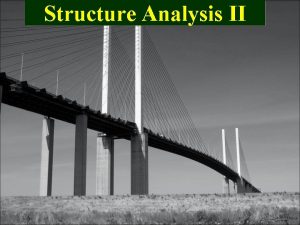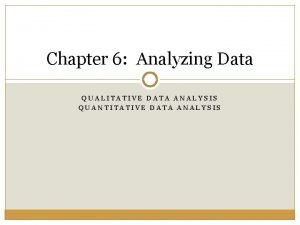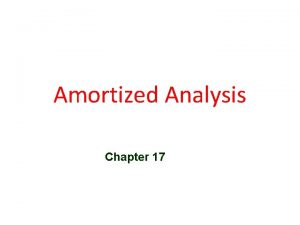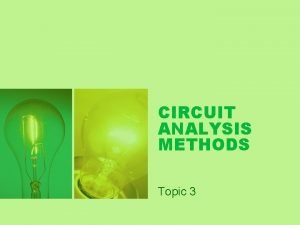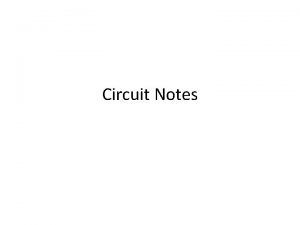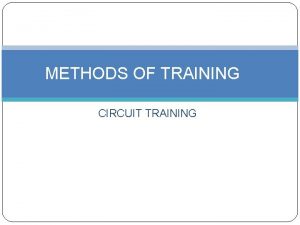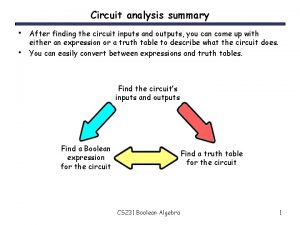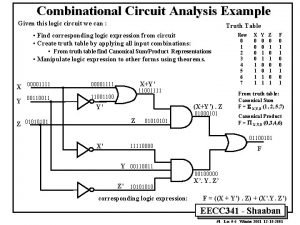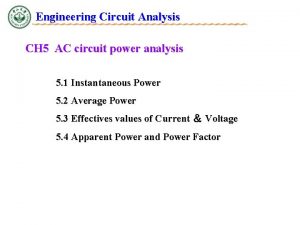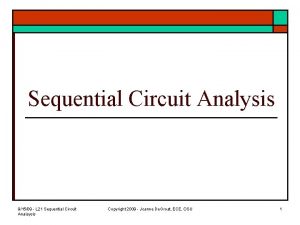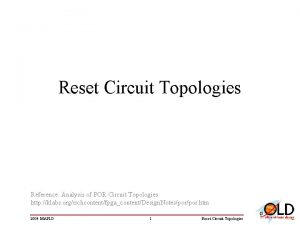Chapter 3 METHODS OF CIRCUIT ANALYSIS I Methods


















































- Slides: 50

Chapter 3 METHODS OF CIRCUIT ANALYSIS I

Methods Of Analysis • 2 powerful techniques for circuit analysis: 1. Nodal Analysis (based on KCL) 2. Mesh Analysis (based on KVL)

Nodal Analysis • Known as – node-voltage method • Use KCL method • Objective: finding node voltage • Assume circuit without voltage sources. • With node voltages known, current in every branch can be calculated

Nodal Analysis v 1, v 2 : node voltages 6 v 1 1 A 2 v 2 7 4 A If v 1 and v 2 are known, current in all branches can be calculated Reference node

Steps for Nodal Analysis 1. Determine number of nodes. 2. Select one node as reference. All voltages will be relative to the reference node. Assign voltage designations to each node where the voltage is unknown. 3. Assign currents at each node where the voltage is unknown.

Steps for Nodal Analysis 4. Apply KCL to each node where currents are assigned. 5. Express the current equations in terms of voltages using Ohm’s Law. 6. Solve the equations for unknown node voltage using any standard method (substitution, elimination, Cramer’s Rule or matrix inversion)

Reference Node • Commonly called ground (assumed zero potential). • Usually use ground as a reference node. • Assign voltage designations to nonreference nodes.

Nodal Analysis 3 nodes • Determine no. of nodes • Select one node as reference Node 3 Node 1 Node 3 Node 2

Nodal Analysis • Assign currents at each node where the voltage is unknown Node 1, v 1 i 2 i 3 Node 1, v 1 :

Nodal Analysis • Assign currents at each node where the voltage is unknown Node 2, v 2 i 2 2 A i 4 Node 2, v 2 :

Nodal Analysis • Apply Ohm’s law to express the unknown current in terms of voltage • Current flow : From higher potential to a lower potential in a resistor.

Nodal Analysis v 1 i 1 v 2 i 3 i 4

Nodal Analysis • Substitute to previous equations gives; Node 1, v 1 : Node 2, v 2 :

Nodal Analysis • Rearrange the equations gives; Node 1, v 1 : Node 2, v 2 : • Solve for the node voltages using any standard method. (substitution, elimination, Cramer’s Rule or matrix inversion)

Nodal Analysis : Substitution method • Based on the equation;

Nodal Analysis : Substitution method • Insert eq (3) into eq (1),

Nodal Analysis : Substitution method • After get v 2, substitute into eq (3) to get the value of v 1

Review on Cramer’s Rule

Review on Cramer’s Rule

Review on Cramer’s Rule

Example 1: Circuit Independent Current Sources Only • Calculate the node voltages in the circuit shown

Example 1 : Circuit Independent Current Sources Only

Example 2 : Current with Dependent Current Sources • Determine the voltages at the nodes in the Figure

Example 2: Current with Dependent Current Sources

Special Case • When a voltage source is the only element between two essential nodes, the node-voltage method is simplified.

Example 3

Solution : Example 3 i. There is three essential nodes, so two simultaneous equation are needed. ii. Only one unknown node voltage, V 2 where as V 1=100 V. iii. Therefore, only a single node-voltage equation is needed which is at node 2.

Solution : Example 3 Using V 1 =100 V, thus V 2=125 V.

Supernode • When a voltage source is between two essential nodes, those nodes can be combine to form a supernode (voltage source is assume as open circuit). • We apply both KCL & KVL to determine the node voltages

Supernode • Properties of a supernode: 1. 2. 3. The voltage source inside the supernode provides a constraint equation needed to solve for the node voltages. Has no voltage of its own. Requires the application of both KCL & KVL

Supernode

Supernode At the supernode, apply KCL:

Supernode To apply KVL to the supernode, redraw the circuit as :

Exercise 1

Exercise 1 Step 1 Determine the reference node Step 2 Assign the rest of the nodes with node voltages (referred to the reference node)

Exercise 1 Step 3 Write down equations using KCL for every non-reference node in terms of node voltages if there are N nodes, there should be (N-1) equations Step 4 Obtain the node voltages by solving the simultaneous equations in step 3

Exercise 2 Determine the current in every branch. 9 k v 1 3 k v 2 9 k 12 V + 6 k 4 k Step 1 Determine the reference node Step 2 Assign the rest of the nodes with nodal voltages Note: only nodes with 3 or more branches are assigned 3 k

Exercise 2 9 k v 1 3 k v 2 9 k 12 V + 6 k 4 k 3 k Step 3 Write down equations using KCL for every non-reference node in terms of node voltages Step 4 Obtain the node voltages by solving the simultaneous equations in step 3

Exercise 3 Circuit containing dependent current source. 6 k v 1 v 2 2 io 12 k 3 k 2 m. A io Step 1 Determine the reference node Step 2 Assign the rest of the nodes with node voltages

Exercise 3 6 k v 1 v 2 2 io 12 k 3 k 2 m. A io Step 3 Write down equations using KCL for every non-reference node in terms of node voltages Step 4 Obtain the node voltages by solving the simultaneous equations in step 3

Exercise 4 Determine v 1 , v 2

Exercise 4 Step 1 Determine the reference node Step 2 Assign the rest of the nodes with node voltages

Exercise 4 Step 3 Write down equations using KCL for every non-reference node in terms of node voltages We cannot write equation for current with branch containing 2 V voltage source ! To avoid this, we will combine nodes 1 and 2 to form a SUPERNODE

Exercise 4 supernode We will use KCL to sum all current going out of supernode: To avoid this, we will combine nodes 1 and 2 to form a SUPERNODE

Exercise 4 supernode We need another equation in order to solve v 1 and v 2 Applying KVL for the loop,

Exercise 4 Step 4 Obtain the node voltages by solving the simultaneous equations in step 3 and

To summarize …. We form a supernode when there is a voltage source in between 2 non-reference nodes For example: Supernode needed since Vs in between nonreference node + Vs +

To summarize …. We form a supernode when there is a voltage source in between 2 non-reference nodes Supernode needed since va in between nonreference node For example: v 2 v 1 We don’t need to form supernode. Also note that v 1 = Vb vb + + va v 3

To summarize …. We form a supernode when there is a voltage source in between 2 non-reference nodes For example: 3 io + +

To summarize …. We form a supernode when there is a voltage source in between 2 non-reference nodes Since we have combined two nodes, we lost 1 equation to solve the circuit. we need one more equation to solve the circuit We write an equation (using KVL) that defines the voltage relationship between the two non-reference nodes that forms the supernodes
 Disadvantages of parallel circuit
Disadvantages of parallel circuit Different types of circuits
Different types of circuits Parallel circuit circuit construction kit
Parallel circuit circuit construction kit Voltage and current series parallel
Voltage and current series parallel What is incomplete circuit
What is incomplete circuit Shorted resistor parallel circuit
Shorted resistor parallel circuit Similarities of series and parallel circuits
Similarities of series and parallel circuits Pulmonary circuit and systemic circuit
Pulmonary circuit and systemic circuit Series parallel circuit current
Series parallel circuit current Circuit training methods
Circuit training methods Advantages and disadvantages of circuit training
Advantages and disadvantages of circuit training Direct wax pattern technique
Direct wax pattern technique Analysis of sequential circuits
Analysis of sequential circuits Pengertian rangkaian sekuensial
Pengertian rangkaian sekuensial Pengantar analisis rangkaian
Pengantar analisis rangkaian Microelectronics circuit analysis and design
Microelectronics circuit analysis and design Ac source transformation
Ac source transformation Current devider rule
Current devider rule Nnn tutorial
Nnn tutorial Phasor circuit analysis example
Phasor circuit analysis example S domain circuit analysis
S domain circuit analysis Ac circuit power analysis
Ac circuit power analysis Dc analysis of bjt circuits
Dc analysis of bjt circuits Laplace transform circuit
Laplace transform circuit Fourier series circuit analysis
Fourier series circuit analysis Analysis of sequential circuit
Analysis of sequential circuit Drain current formula in mosfet
Drain current formula in mosfet Rangkaian linier adalah
Rangkaian linier adalah Electrical circuit analysis
Electrical circuit analysis Sequential circuit analysis
Sequential circuit analysis Engineering circuit analysis
Engineering circuit analysis Persamaan diferensial orde 2
Persamaan diferensial orde 2 Source transformation
Source transformation Npn operation
Npn operation Solving circuits using graph theory
Solving circuits using graph theory Test source method circuit analysis
Test source method circuit analysis Resistive circuit analysis
Resistive circuit analysis Sneak circuit analysis
Sneak circuit analysis Find v
Find v Laplace transform of inductor
Laplace transform of inductor Circuit analysis with diodes
Circuit analysis with diodes Fact-finding techniques in system analysis and design
Fact-finding techniques in system analysis and design Energy methods in structural analysis
Energy methods in structural analysis Feedback analysis methods
Feedback analysis methods Data collection in legal research
Data collection in legal research Data analysis methods
Data analysis methods Methods of job analysis in industrial psychology
Methods of job analysis in industrial psychology Inorganic precipitating agents examples
Inorganic precipitating agents examples Scree plot factor analysis
Scree plot factor analysis Aggregate method in amortized analysis
Aggregate method in amortized analysis User interface design in system analysis and design
User interface design in system analysis and design












